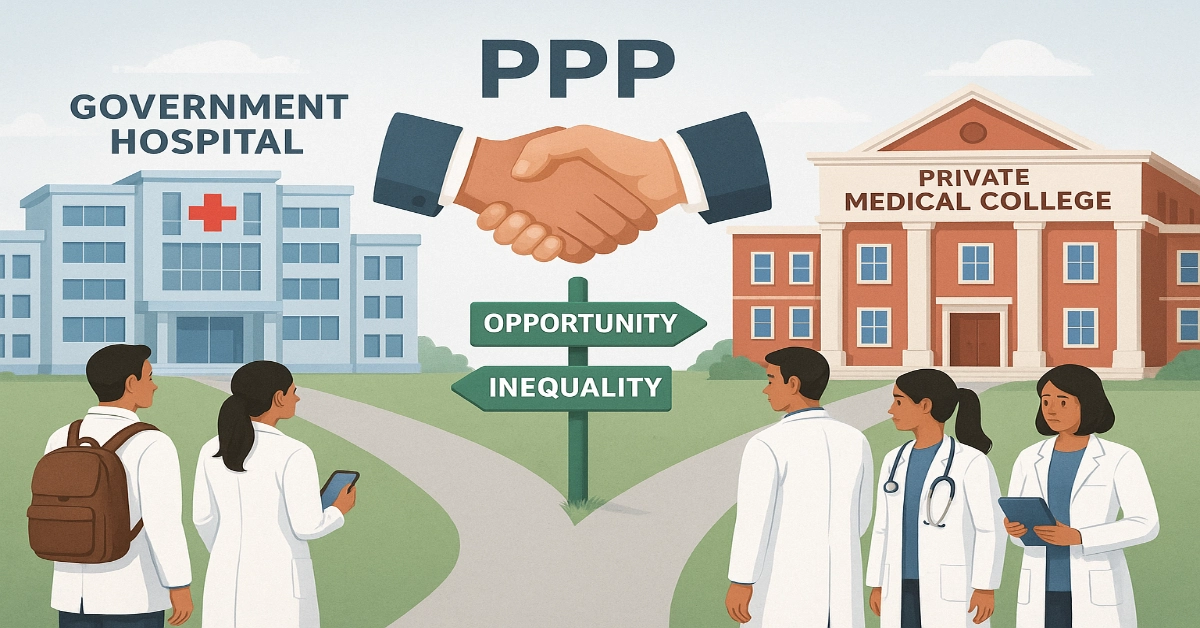PPP in Medical Education: India is struggling with a permanent shortage of doctors and an uneven distribution of medical colleges across states. In this academic year, the country has 808 medical colleges offering 1,23,700 MBBS seats, yet many districts remain devoid of such institutions.
To expedite medical college expansion in India, governments have supported Public-Private Partnerships (PPPs), arrangements where private partners construct or manage medical colleges using public assets such as district hospitals.
| Speakers at a Roundtable held in Visakhapatnam warned that introducing a Public-Private Partnership (PPP) model in medical education risks undermining equitable access for students from economically weaker backgrounds. The event, organised by the People For India Visakhapatnam Forum, brought together educationists, former administrators, activists, students, and health policy experts to deliberate on the implications of leasing government medical colleges to private operators for long tenures. |
Advocates of Public–Private Partnerships (PPPs) claim that PPPs help mobilise capital, improve infrastructure, and relieve state budgets. Critics, meanwhile, counter that they threaten equity, affordability, and public accountability.
This article critically examines PPP in India’s medical education sector: defining PPPs, exploring models, reviewing policies and funding, assessing claimed advantages and real drawbacks, especially for poorer students, and offering reforms.
What is PPP in Medical Education?
A Public–Private Partnership (PPP) is a cooperation between the public and private sectors. In education, PPP typically involves a contract where the private party invests capital, undertakes infrastructure or operations, and recovers costs (generally profitably) through user charges or government payments.
In the medical education context, PPPs often involve:
- Private partners designing, building, and operating medical colleges (sometimes linked with hospitals)
- Use of public land, infrastructure (e.g., district hospitals)
- Cost recovery via tuition, hospital charges, and government support
- Shared responsibilities and risks over long concession periods
This differs from traditional government-aided institutions, which are essentially non-profit and heavily state-subsidised.
Read Also: NMC MBBS Expansion 2025: Why 808 Colleges & 123700 Seats Can’t Fix Broken Medical Education System?
Models of PPP in Medical Education
Design-Build-Finance-Operate (DBFO)
- Under this model, a private entity takes full responsibility for designing, financing, constructing, operating, and maintaining a medical college (and related hospital upgrades) for a fixed concession period (e.g., 60 years).
- The NITI Aayog’s draft concession agreement envisages precisely this, tied to district hospitals in underserved districts.
Management Partnership
- Here, the government contributes infrastructure or hospital assets, while private partners manage clinical and educational operations.
- An example is Kasturba Medical College (KMC), Mangaluru, which collaborates with public hospitals to deliver services and train students.
Semi-Private/Joint Venture Models
- In such arrangements, governance and funding are shared. Governments, private trusts or societies co-manage institutions.
- The GMERS model in Gujarat approximates this: government colleges that operate with cost-recovery structures and often high fees.
VGF-Assisted Pilot Projects
- The government uses Viability Gap Funding (VGF) to make PPPs viable in less-developed areas.
- The Centre and states subsidise a portion of capital and operational costs to attract private participation.
Critics claim that including a private player will only create a monopoly, directly or indirectly, in medical education in India, which will hurt the poorest the most, no matter what models of PPP are applied.
Key Government Policies and PPP Initiatives
NITI Aayog Draft Concession Agreement (2019)
- NITI Aayog’s draft concession model argues that state resources alone cannot meet medical education demand.
- It proposes a 60-year concession period in which the private partner may collect tuition and hospital charges, while reserving a set number of beds for regulated (free) care.
- This cross-subsidy model seeks to balance profitability with public interest.
Viability Gap Funding (VGF) Scheme
To incentivise private investment, the VGF scheme provides:
- Up to 30% of capital costs (central) + possibly additional from states
- For select projects, up to 40% capital subsidy
- Subsidies toward operating and maintenance costs (shared by the Centre and states)
However, critics label this as public funds flowing into private profits, without strong conditions to protect students and patients.
State Experiments in PPP
Andhra Pradesh
- Proposed to establish 10 new medical colleges via PPP to save capital and operating costs.
- The scheme plans 150 seats per college, reserving 75 under government quotas.
- It promises free outpatient and free inpatient care for 70% of beds, while remaining “paid beds” generate revenue.
Bihar
- The Bihar government has announced plans to involve private companies in managing select public medical colleges and hospitals through a Public–Private Partnership (PPP) model.
- Under this initiative, the state will provide land and a portion of the capital investment required to establish new medical institutions, while private partners will take responsibility for funding, building, and operating these facilities.
Read Also: Bihar New PPP Model for Medical Colleges: Benefits and Drawbacks
Gujarat (GMERS)
- Government quota fees were raised dramatically, from ₹3.3 lakh to ₹5.5 lakh, management quota fees to ₹17 lakh, and NRI quota to around US$25,000.
West Bengal
- The JIS School in Kolkata, under a PPP-like framework, charges ₹5.48 lakh for government quota seats, ₹21.7 lakh for management quota, and ₹28.44 lakh for NRI seats.
- It shows how PPP-influenced colleges often charge much higher fees.
Legal & Judicial Developments
- Some states encouraged PPP via new legislation (e.g., Tamil Nadu Private Universities Act, 2019).
- Courts have occasionally balanced the idea, upholding oversight and social justice prerogatives, but a civil society has challenged the aggressive privatisation of planned government colleges.
Read Also: Medical Education in India 2025: MBBS Seat Expansion, AI Integration, and Fee Trends Explained
Funding & Cost Recovery in PPP Medical Colleges
- Public Subsidies & Land Grants: Many PPPs secure land or hospital infrastructure at token or negligible rentals, effectively reducing private costs.
- High Tuition & Fees: Management, NRI, and “private” quota seats in PPP colleges often command astronomical fees, many times higher than in public colleges.
- Hospital Revenue: Private partners operate clinical services, charging paying patients, while the PPP model may mandate that some beds be reserved for free or subsidised care.
- Cross-Subsidisation: The revenue from paid services and high-fee seats is expected to subsidise free or regulated services.
These mechanisms make PPP ventures financially viable, but also shift cost burdens onto students and middle-income patients.
Read Also: India’s Medical Education Revolution: NMC Reforms, CBME, NEXT & More
Claimed Benefits of PPP in Medical Education
Rapid Expansion of Seats and Infrastructure
- Private capital can accelerate the establishment of colleges.
- Andhra Pradesh’s PPP plan aims to add 1,100 additional MBBS seats across 10 new colleges.
- On a national scale, the expansion to 808 medical colleges and 1,23,700 MBBS seats is partly attributed to private and PPP initiatives.
Modern Facilities & Technological Advantage
- Private partners often invest in state-of-the-art infrastructure, digitised learning, telemedicine, and AI-based tools, which may be beyond the immediate reach of government budgets.
Efficiency in Execution & Management
- Private entities are believed to deliver projects with fewer delays, better contract management and practical accountability compared to some purely government-run colleges.
Fiscal Relief & Risk Transfer
- PPP shifts much of the capex, maintenance, and operational risk to the private partner
- Governments can expand capacity with relatively lower upfront costs.
Showcase Model: KMC, Mangaluru
- KMC’s long-standing association with public hospitals has delivered free treatment, high patient volumes, and quality student exposure.
- It often gets showcased as an example of how partnership can align public health goals with educational needs.
PPP in Medical Education: Criticisms and Negative Impact
High Fees and Exclusion of Poor Students
- PPP colleges frequently charge ₹5-20+ lakh per annum, pricing out lower-income families.
- Government colleges, in contrast, often charge ₹20,000-₹50,000 annually.
- Critics warn that PPP becomes a pathway for privileged students only, undermining social equity.
Reduced Access to Free Healthcare
- In linked district hospitals, PPP models may convert many beds into “paid beds.”
- Activists caution that this can erode public healthcare, shifting treatment from free to fee-based, and pushing out the poor.
Hidden Privatisation of Public Assets
- Leasing district hospitals and land to private concessionaires (sometimes for decades) essentially transfers public infrastructure control to private hands, often with nominal return to the public.
Escalating Medical Costs & Inflation
- When public hospitals convert to hybrid models, their service charges may approach private hospital levels, driving up costs for all patients.
Weak Oversight and Quality Concerns
- Many PPP contracts are not open to public scrutiny.
- Without robust regulatory frameworks, private operators may skimp on teaching quality, prioritise profit over access, and evade reservation mandates.
How Poor Students Suffer in PPP Medical Colleges
Heavy Debt Burden & Career Distortion
- Many students taking high-fee seats graduate with significant debt, pushing them into higher-earning specialties or corporate hospitals, rather than rural service.
- This shifts the workforce away from where doctors are most needed.
Dilution of Reservation Policies
- PPP institutions may resist or undermine SC/ST/OBC and EWS reservations.
- The high fees themselves become de facto exclusionary filters, even where quotas exist.
Urban Concentration & Rural Neglect
- Graduates burdened with heavy fees may avoid rural postings, exacerbating the very health inequities PPP was intended to alleviate.
Gender & Social Stratification
- High-cost admissions often favour families able to invest heavily in education.
- Girls or marginalised-origin students may be deprioritised in such investments, reinforcing inequality.
Read Also: India’s Public Health System Fails the Poor: Study Highlights Urban-Rural Gaps
Reforms for Equitable PPP in Medical Education in India
Transparent Contracts & Open Disclosure
- Make PPP concession agreements, fee norms, and audits publicly available.
- Bring private entities within the ambit of RTI and social audits.
Fee Regulation & Cross-Subsidy Limits
- Cap tuition fees relative to public colleges.
- Ensure cross-subsidy does not mean arbitrary overcharging of paying patients.
Guaranteed Quotas & Targeted Scholarships
- Mandate reserved seats for economically weaker sections with full support (fee waiver or subsidy).
- Establish dedicated scholarship funds for underprivileged aspirants.
Robust Regulatory Oversight
- A dedicated authority must monitor institutional compliance, audit operations, enforce penalties, ensure reservation, and maintain quality.
Strengthen Public Medical Colleges First
- Before pursuing PPPs, governments should complete pending public medical college projects and modernise existing ones.
Prioritise Not-for-Profit or Social Models
- Encourage participation by trusts, NGOs, and philanthropic hospitals that operate without profit motives.
Community & Social Accountability
- Involve local communities, NGOs, and patient groups in oversight, social audits, and grievance redressal.
Can PPP Be the Answer for India’s Doctor Shortage?
PPP in medical education is a compelling policy tool with the potential to address India’s medical infrastructure gap. In theory, it mobilises capital, introduces efficiencies, and speeds up capacity expansion. When carefully regulated, PPPs can supplement public efforts, but must not replace them.
Yet, unless strongly safeguarded, PPPs risk reinforcing inequality, excluding poor students through high fees, and weakening the spirit of universal healthcare.
For PPPs to be instruments of public good, not private gain, policymakers must insist on transparency, equity, accountability, and social purpose. Only then can India balance the drive for medical expansion with the imperative of inclusive, fair education and health access.


